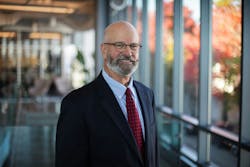Suffolk’s new West Coast Region President measures success by improved productivity
Five years ago, after a 38-year career with the GC Swinerton that included stints as its CEO and Chairman Emeritus, Jeffrey Hoopes retired at the age of 61. During his tenure there, Hoopes helped guide Swinerton’s growth from a relatively small builder to a national firm that generates around $6 billion in annual revenue.
It didn’t take long for Hoopes to realize that his retirement may have been premature; that he was finding it difficult to replace the excitement and challenges he had been used to leading a large construction company.
Then, two years ago, Hoopes was offered a new outlet when John Fish, CEO of Suffolk, asked Hoopes to join his firm in an advisory capacity. Hoopes had already known Fish as a “dynamic” leader, and was impressed with the younger corps of operational executives Fish had assembled at Suffolk.
Hoopes accepted, not knowing at the time that Fish would eventually ask him to help Suffolk expand in the western United States, where “John sees a huge opportunity for Suffolk.” (California recently overtook Japan to rank as the world’s fourth-largest economy based in gross domestic product. And Hoopes notes that high-tech talent that had previously left California for greener pastures in Texas and elsewhere has been returning to the Bay Area.)
Energized in his new role as West Coast Region President, the 66-year-old Hoopes’ goal is to make Suffolk into one of California’s top five general contractors. That goal, he states, will necessitate Suffolk taking more control of the construction management process to improve in-field productivity.
Investing in an automated future
One of the things that led Hoopes to Suffolk was the firm’s willingness to invest in technology and sector growth.
At a time when most contractors spend very little on research and development, Suffolk launched Suffolk Technologies, an institutional venture capital firm that has backed 55 construction tech startups. For example, Suffolk invested in and piloted predictive solution companies such as nPlan and piloted tools from Alice Technologies. Suffolk also invested in, piloted and is now scaling Rugged Robotics, a startup that leverages robot-powered automation to modernize the entire floor layout process.
To elevate its presence in growing building sectors, Suffolk has created Centers of Excellence that are dedicated national teams with specialized skills in key industries. These experts offer their experience and knowledge to projects all over the country, delivering strategic support, solving unique challenges, and leading the way in sector innovation. Suffolk currently has Centers of Excellence for Aviation & Transportation, Mission Critical, Federal Government, Gaming, and Advanced Manufacturing.
Ultimately, Suffolk’s target is to generate at least 60% of its annual revenue from nonresidential projects. To that end, Suffolk has set up a special projects group focused on tenant improvements to attract more renovation business. Hoopes points to a recent survey that found the top 10 builders in the Bay Area producing, on average, two-fifths of their revenue from the reno market.
Seeking more jobsite control
When Hoopes first entered the construction field, “everything was done by hand,” he recalls. So the biggest change during his career has been the shift toward technology and automation, coupled with the knowledge that recent college graduates come into the business with. “The college grads and young professionals are so bright, and ready,” he observes.
Another change that has surprised him somewhat is the resurgence of self-performing by GC firms, after a period when most firms were content in their construction management roles that reduced their risks. “Owners want this,” he says about self-performing, and some public clients have gone so far as to specify in their RFPs what tasks they expect to be self-performed.
The big question mark now for GCs, says Hoopes, is figuring out how artificial intelligence can help them squeeze more productivity out of their projects. Suffolk is already putting co-labs on its jobsites to determine where some of its administrative staff can be reduced or shifted “to do something else.”
Hoopes is convinced that managing productivity will separate the winners and losers among GCs going forward. To get better at management, Hoopes suggests that Suffolk needs to broaden its scope on projects. The firm has 43 registered architects on staff. Design is already automated, and procurement is next. Big GCs like Suffolk will become big purchasers and, eventually, control the engineering subcontractors on the jobsite.
Over the next five years, Hoopes predicts, Suffolk will be doing more self-performing, more design-building using AI-generated models, and have more overall control of the projects it engages. “You’ll own the risk anyway,” he says. And he expects that Suffolk needs to be ready to meet head-on more changes in the industry over the next decade than what occurred in the past century.
Hoopes says he’s stimulated, professionally and personally, by the challenges that lie ahead. It might be an exaggeration to say he’s a still a workaholic, but Hoopes says he’s winding down the vineyard and winery he and his wife own in Mendicino because he’s going to be occupied for a while taking Suffolk to its next level.
About the Author

John Caulfield
John Caulfield is Senior Editor with Building Design + Construction Magazine.

